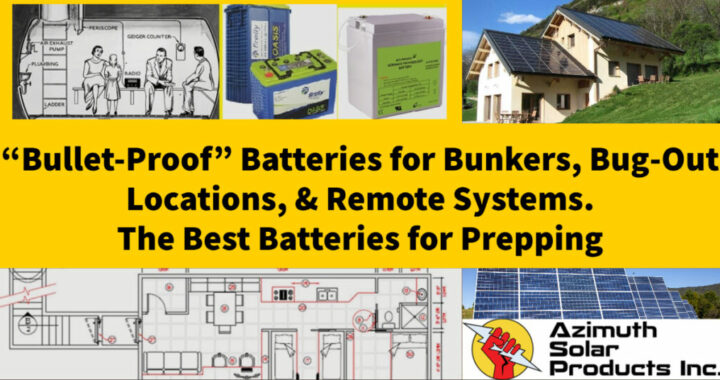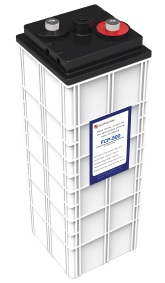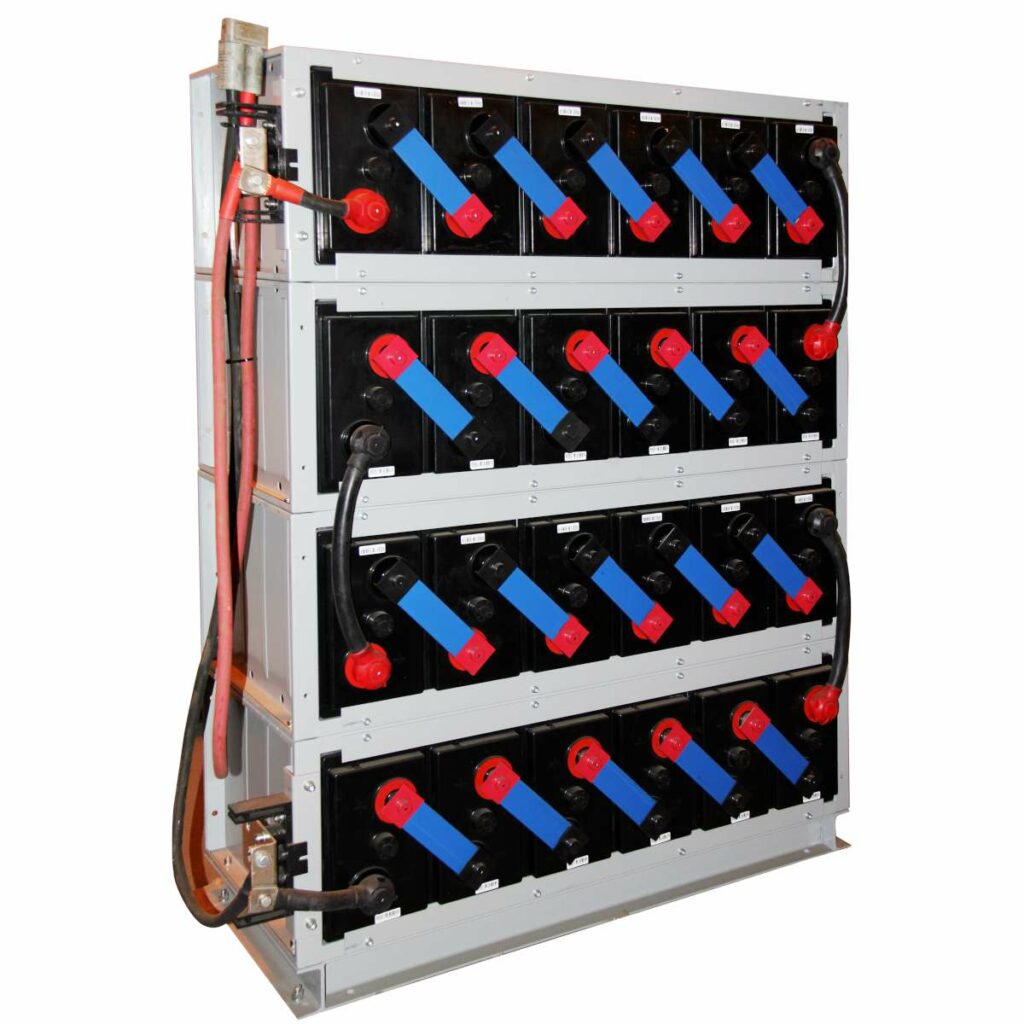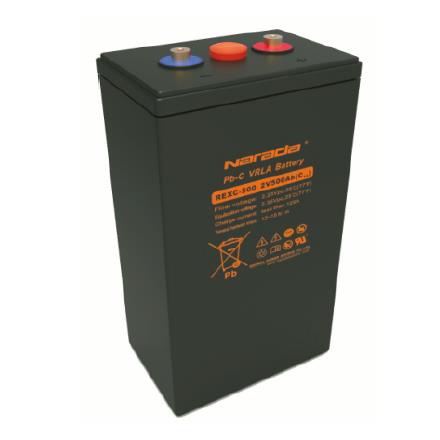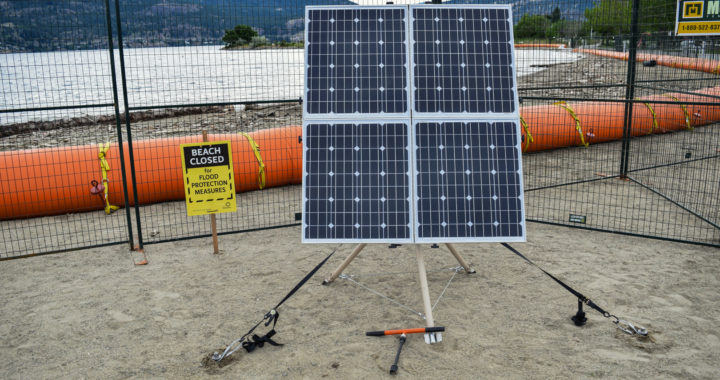Emergency preparedness, energy independence and interest in bunkers, shelters and bug-out locations is growing at an accelerating rate; battery storage is a key component of a successful shelter.
Whether you’re sheltering in place (bugging-in), or going to a safe remote location (bugging-out), you want your critical systems and equipment to be operational when supplies are scarce and you need them the most.
New battery types available can provide over 5 times the lifespan of regular batteries, without freezing, drying-out, off-gassing, or needing frequent maintenance. They are already being adopted for use in remote telecom relay towers, mining, marine, and military applications. Their longer lifespans also mean lower lifetime costs since the time between replacements is extended by years to decades.
If you get to your “safe” location, and nothing works, and you have no power for critical equipment, you are in serious trouble!
Power needs for locations can range from a few lights, communication and tools, to more sophisticated shelters.
Power needs include:
- Lighting
- Communications
- Computers
- Refrigeration for food and medicines
- Freezer for food and ice (ice has many uses)
- Entertainment
- Cooking appliances
- Medical equipment like oxygen concentrators and CPAP
- Fans and air exchange systems
- Water pumps and filtration
- Electric livestock fencing
- Security systems
- Powered door systems
- Sump Pumps *
- Lighting
- Communications
- Computers
- Equipment battery charging (electric drills, etc)
- Powered door systems
*Approximately 90% of the underground locations under 30 ft depth have water ingress problems, either from the water table or from rain.
An unexpected loss of power could mean flooding or even loss of breathable air in some situations. Even people with simple systems often require power for a CPAP, circulation fans and lighting.
Typical deep-cycle batteries are rated by the number of charge and discharge cycles that they can handle, at 50% depth of discharge capacity. Depending on the quality, 500 charge-discharge cycles for a low-cost battery, to around 1,200 cycles for a premium brand are the normal lifespan expectation (2-5 years). Lower-cost flooded batteries often off-gas dangerous fumes, which can cause fires or explosions in unventilated enclosed spaces. They also require regular maintenance, which can give your location away to potential threats, or require you to visit frequently. Flooded, AGM and GEL batteries are vulnerable to freezing, which can break the casing and kill the batteries. These batteries can also degrade quickly from internal corrosion and sulfation, when left only partially charged for an extended time.
The solution is to use a more durable battery for prepping, bunkers and bug out locations. Eliminate the pitfalls of older, less reliable battery chemistries. Avoid the over-reliance on Internet connectivity, complexity, high cost and narrow temperature ranges of lithium ion battery systems.
Consider more stable chemistries like silicon dioxide aka “lead-crystal” batteries, and carbon foam / lead carbon batteries. These improved batteries have ultra-long deep-cycle lives, don’t off-gas, and don’t require maintenance. They have longer shelf-life and are not as vulnerable to EMP events or electronic failure because they do not require complex Battery Management Systems to function.
And importantly, these batteries do not require a connection to the Internet so you can keep your location safe and private!
Silicon-Dioxide (SiO2) AKA Lead Crystal Batteries:
A variety of sizes are available for different applications in a selection of voltages, but the most common are 12V and 6V batteries.
Originally developed in the 1970’s by the US military, to be a liquid-free “dry” battery that could literally be shot and not leak its contents; these went from an early-stage, low-output weakling to a hard hitting contender, using modern nanomaterials.
Silicon-dioxide (SiO2) batteries boast among the best temperature ranges and high cycle-life of any lead-based battery. Averaging 2,800 cycles at 50% depth of discharge, these outperform most premium batteries by 2-3 times their lifespans. By reducing sulfuric acid content by over 95%, these contain virtually no liquid inside to freeze, spill, or off-gas. The result is a battery that resists sulfation and corrosion, even if fully discharged. SiO2 batteries have an impressive -40C/F to +65C/149F temperature range; making them ideal for remote arctic or desert locations. The non-corrosive electrolyte is more environmentally friendly in this 99% recyclable battery. These are available in a wide variety of sizes and voltages.
The SiO2 batteries can charge in about half the time of normal deep-cycle batteries, conserving generator fuel and reducing your exposure to carbon-monoxide. Generator noise and exhaust can attract unwanted attention. Paired with solar, hydro or wind generation, a SiO2 battery bank is well suited for a self-sustaining, secluded off-grid retreat.
SiO2 batteries are excellent for winter or summer high temperature use in off-grid homes, bug-out locations, underground shelters, cabins, cottages, marine and RV’s, scooters and golf carts. They can handle extreme temperature conditions without heating or cooling systems. They are extremely well-suited for outdoor applications; such as remote monitoring, security systems, trail cams, emergency lights, mobile equipment, water pumps, electric fences, UPS backup systems and communication relays.
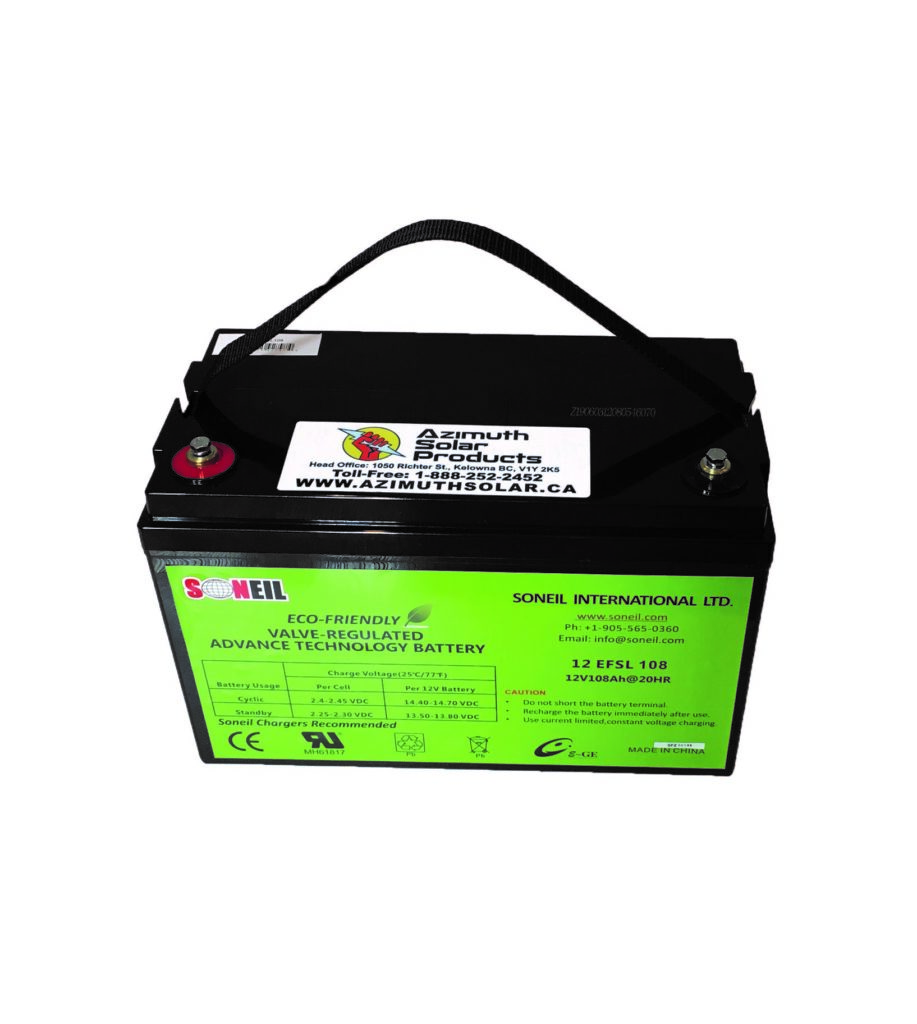
100Ah 12V G27H SiO2 Battery 
270Ah 12V Group D SiO2 Battery 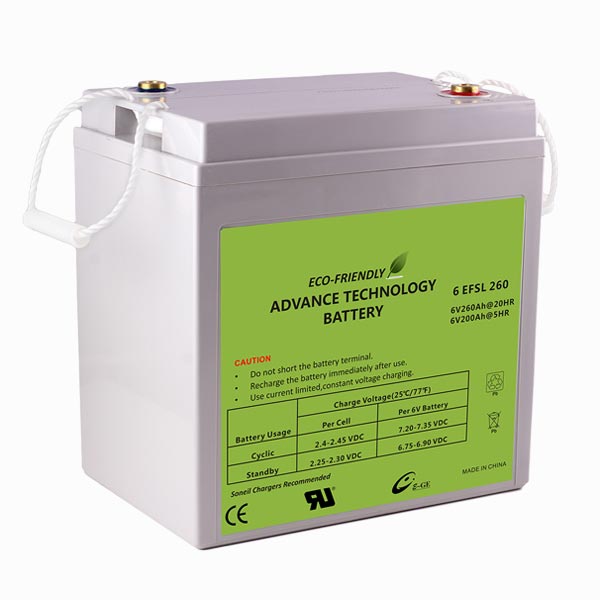
260Ah 6V GC2 SiO2 Battery
- Temperature range: -40C/F to +65C/149F Great for sub-freezing conditions to high desert heat.
- Charge time: Fast 4Hrs from fully depleted. (0.25C rate)
- Cycle Life: 2,800 Cycles @ 50%, 1,500 @ 80%. Can be discharged 100% and recover full capacity
- Shelf-life: 2yrs without trickle-charging
- Max Discharge Rate: Up to 9C (9 x rated Ah capacity <5 Secs) High surge cranking power.
Lead Carbon Batteries by Sacred Sun & Narada:
With some of the industry’s best cycle-life performance at deep discharge, these battery systems are designed for high-capacity banks for off-grid homes, telecom, and commercial applications. These batteries are capable of high cycling and Partial State of Charge (PSOC) conditions without degradation. Similar to carbon-foam batteries, Lead Carbon AGM batteries can provide extreme cycle-life lithium-performance at about half the cost of lithium. Unlike lithium batteries, these do not require a BMS (Battery Management System) to prevent failures from imbalanced cells, as they self-balance. They have no risk of thermal run-away, a condition that can cause lithium cells to overheat and burn.
These modular design of the battery banks allow for simple to setup systems that can be configured as 12V, 24V, or 48V sets, with 500 to 5,000+Amp Hour capacity. 6kWh to MWh scalable systems.
- Cell Sizes: 2V 500Ah (10hr) to 2V 2000Ah (10hr) Capacity
- Temperature range: -15C/F to +45C/F
- Charge time: 0.1C to 0.2C, (5-10hr rate)
- Cycle Life: 5,000+ Cycles @ 50% DoD, 3,500 @ 80% DoD
- 15yr+ Design Life at 70% DoD: 4,200 Cycles
- High Discharge: 0.4C: 400A Max Continuous Discharge for 1000Ah cells
Standard Lead Acid Batteries
These batteries come in Flooded, AGM and Gel varieties. Flooded battery banks often need a watering system, proper venting and regular maintenance to prevent sulfation damage. They are prone to freezing damage when temperatures drop below -18C if not kept fully charged, and can suffer from electrolyte loss and break-down in hot conditions. Checking and topping off the electrolyte levels adds additional complexity and danger of splashing or spills. The vapors from these batteries tend to corrode nearby terminals and electronics. AGM and Gel, (VRLA/Sealed), batteries eliminate the need for regular maintenance and ventilation at a higher price, but still have temperature and lifespan limitations. Well known batteries of this type include Trojan, Outback, Interstate and Rolls-Surrette. The cycle life of these batteries commonly range from 600- 1400 cycles @ 50% depth of discharge.
Nickel-Iron Batteries
Nickel-Iron Batteries have exceptionally long lifespans, but require weekly maintenance and a lot of ventilation. They are lower in efficiency, with a self-discharge at about 1% per day. If left unattended, they can dry out or lose their charge relatively quickly. They are a higher cost and much heavier and about 9-times larger than a lead-acid battery of the same power storage capacity. Charging efficiency is only approximately 65% of the power put in, vs approximately 90% for most other battery types. Many solar charging systems are not compatible with the narrow voltage requirements of these batteries.
Lithium-ion Batteries
Lithium-ion batteries can charge quickly and have a great cycle-life capability. They are more compact than regular deep-cycle batteries. A limiting factor is that they can only be charged above 0C/32F. Unless lithium cells are above freezing temperatures, lithium ions will electroplate onto the anodes, lowering capacity, and permanently damaging your batteries. A lithium Battery Management System (BMS) will shut off charging at freezing temperatures, so for winter-time, your batteries could be either quickly drained, or damaged if not kept in a heated location. Lithium Ion batteries used in vehicles or Tesla Powerwalls have a heating system built into the power pack to overcome this; drawing extra power off the charging system. Another consideration for Lithium-ion Batteries is that BMS systems for most DIY or retail li-ion batteries are often limited in their power output. You may have a large battery bank but may only be able to draw 50-100A current per battery on a continuous basis.
Tesla Powerwalls and some other lithium banks require Internet connectivity to work and manage. Most of these must directly communicate with the manufacturer on a regular basis for updates and diagnosis or they could stop working. This may compromise the security of your location. Tesla Powerwall batteries require installation and maintenance by a certified technician.
Available soon: Lithium Titanate, LTO Batteries:
Lithium Titanate, or lithium-titanium-oxide batteries have the highest cycle-life of any battery currently available. 20,000 -30,000 cycles at 100% DoD! They can be fully charged in approximately 6 minutes and output current at 10 times their capacity rating, They are the most thermally stable of available lithium chemistries, and are not subject to thermal runaway; no fire risk.
Unlike other lithium-ion batteries, these do not require heating to be charged in freezing temperatures, with a charge and discharge temperature range of -50C/-58F to +65C/149F.
These are not as energy-dense as other lithium chemistries, but are still only about 2/3 the weight of a lead-acid battery with the same power capacity. Their fast discharge and recharge cycle ability has made them extremely useful for high-cyclic use, where frequent recharges are needed. Applications where these batteries are being used include Amazon’s robotic inventory systems, and high-output applications such as turbine ignition systems for military jets.
Azimuth Solar Products has recognized that their extreme safety, temperature range, and 25 to 50+ year durability makes these ideal for rugged, reliable systems, which can withstand intense use and environments. Scalable battery packs (12V, 24V, and 48V) are under development for production in Canada this fall. These will be available in standard 100-150A charge/discharge capable packs, and high charge/discharge rate packs with 400A+ capability. Information available on request.
Final Thoughts
There are battery chemistries and concepts still in experimental and development stages. Graphene super-capacitors, salt-water batteries, thermal storage, flow batteries, and other lithium variations are some examples. Many of these are either years away from commercialization or have proven to be too expensive for consumer use or only suited for large utilities.
Having batteries that can go long intervals without charging or maintenance, are sealed for use in confined spaces and that can last several lifetimes of a regular battery; will save you money, time, and possibly your life, in the long-run. For specifications, whitepapers and other additional information, please contact Azimuth Solar Products Inc. info@azimuthsolar.ca Toll-Free: 1-888-252-2452 This is the Canadian website. For the US website, go to www.azimuthsolarproducts.com

